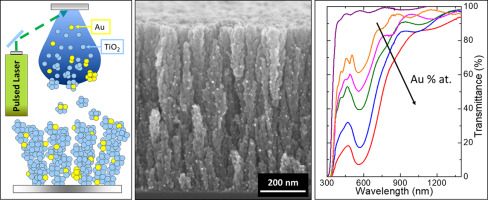当前位置:
X-MOL 学术
›
Mater. Des.
›
论文详情
Our official English website, www.x-mol.net, welcomes your
feedback! (Note: you will need to create a separate account there.)
Integration of plasmonic Au nanoparticles in TiO 2 hierarchical structures in a single-step pulsed laser co-deposition
Materials & Design ( IF 7.6 ) Pub Date : 2018-10-01 , DOI: 10.1016/j.matdes.2018.06.051 Beatrice Roberta Bricchi , Matteo Ghidelli , Luca Mascaretti , Andrea Zapelli , Valeria Russo , Carlo Spartaco Casari , Giancarlo Terraneo , Ivano Alessandri , Caterina Ducati , Andrea Li Bassi
Materials & Design ( IF 7.6 ) Pub Date : 2018-10-01 , DOI: 10.1016/j.matdes.2018.06.051 Beatrice Roberta Bricchi , Matteo Ghidelli , Luca Mascaretti , Andrea Zapelli , Valeria Russo , Carlo Spartaco Casari , Giancarlo Terraneo , Ivano Alessandri , Caterina Ducati , Andrea Li Bassi

|
Abstract The plasmonic resonance of noble metal nanoparticles (NPs) can be exploited to enhance the photoresponse of wide band gap oxides in view of several solar energy applications. Here, we demonstrate single-step synthesis of plasmonic Au nanoparticles integrated in TiO2 hierarchical nanoporous layers through a vapor phase pulsed laser co-deposition approach. Specifically, we report the fabrication and characterization of Au NPs-decorated TiO2 forest-like systems with tunable porosity and density as well as the morphological/structural evolution as a function of Au content and we discuss the corresponding optical properties. The effect of post-deposition thermal treatment has been investigated as well in order to control TiO2 crystallization and Au NPs nucleation and growth. Optical analyses show the onset of characteristic plasmonic resonance of Au NPs with the increase of film absorption in the visible range. Preliminary tests of photodegradation of methyl orange dye indicate that the integration of Au NPs leads to a significant increase of the catalytic activity of nanoporous TiO2. Our results suggest the potentiality of this approach for the synthesis and the integration of metallic NPs within wide band gap semiconductors, while paving the way toward novel plasmonic-based devices.
中文翻译:

在单步脉冲激光共沉积中将等离子体 Au 纳米颗粒集成到 TiO 2 分级结构中
摘要 鉴于多种太阳能应用,贵金属纳米粒子 (NPs) 的等离子体共振可用于增强宽带隙氧化物的光响应。在这里,我们展示了通过气相脉冲激光共沉积方法集成在 TiO2 分级纳米多孔层中的等离子体 Au 纳米颗粒的单步合成。具体而言,我们报告了具有可调孔隙率和密度的 Au NPs 装饰的 TiO2 森林状系统的制造和表征,以及作为 Au 含量函数的形态/结构演变,并讨论了相应的光学特性。还研究了沉积后热处理的影响,以控制 TiO2 结晶和 Au NPs 的成核和生长。光学分析表明,随着可见光范围内薄膜吸收的增加,Au NPs 的特征等离子体共振开始。甲基橙染料光降解的初步测试表明,Au NPs 的整合导致纳米多孔 TiO2 的催化活性显着增加。我们的研究结果表明,这种方法具有在宽带隙半导体中合成和集成金属 NP 的潜力,同时为新型等离子体器件铺平了道路。
更新日期:2018-10-01
中文翻译:

在单步脉冲激光共沉积中将等离子体 Au 纳米颗粒集成到 TiO 2 分级结构中
摘要 鉴于多种太阳能应用,贵金属纳米粒子 (NPs) 的等离子体共振可用于增强宽带隙氧化物的光响应。在这里,我们展示了通过气相脉冲激光共沉积方法集成在 TiO2 分级纳米多孔层中的等离子体 Au 纳米颗粒的单步合成。具体而言,我们报告了具有可调孔隙率和密度的 Au NPs 装饰的 TiO2 森林状系统的制造和表征,以及作为 Au 含量函数的形态/结构演变,并讨论了相应的光学特性。还研究了沉积后热处理的影响,以控制 TiO2 结晶和 Au NPs 的成核和生长。光学分析表明,随着可见光范围内薄膜吸收的增加,Au NPs 的特征等离子体共振开始。甲基橙染料光降解的初步测试表明,Au NPs 的整合导致纳米多孔 TiO2 的催化活性显着增加。我们的研究结果表明,这种方法具有在宽带隙半导体中合成和集成金属 NP 的潜力,同时为新型等离子体器件铺平了道路。











































 京公网安备 11010802027423号
京公网安备 11010802027423号